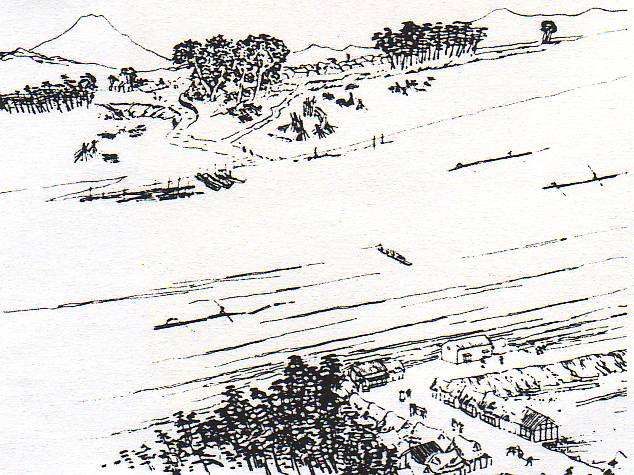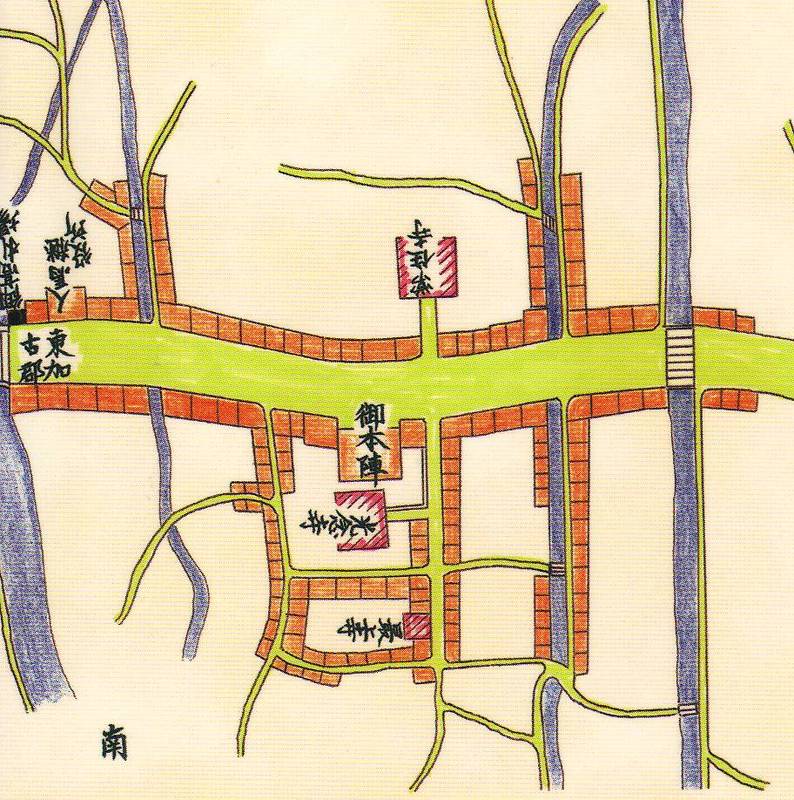寛延(かんえん)の大一揆(1748~49)
播磨地方では、1743年から6年間に4度も大きな台風にみまわれ、凶作となりました。でも、台風の被害は播磨地方だけの出来事ではありません。
姫路藩には特別な事情があったと考えられます。
話を少しさかのぼります。
 1742年(寛延2)藩主、松平明矩(あきのり)が奥州白河から姫路へ移ることになりました。
1742年(寛延2)藩主、松平明矩(あきのり)が奥州白河から姫路へ移ることになりました。
この費用だけでも莫大なものでした。その費用は江戸や大坂の商人の借金で賄われました。
その上、八代将軍が亡くなり、家重(いえしげ)が9代将軍となりましたが、この時朝鮮国からこれを祝うために1748年6月476人が来朝したのです。
一行は、姫路藩の室津に立ちよります。
その接待費2万両は姫路藩の負担になりました。
そんな、お金はありません。商人は、返してもらえる保障のないお金は姫路藩には貸しませんでした。当然の結果として、増税です。
それに、姫路藩の藩主は短い間に、次々と変わりました。
そのため藩の事情に通じている大庄屋の役割が非常に大きくなり、年貢の取り立てなどで大庄屋は目だった存在になりました。
農民の不満はいきおい、大庄屋にむかいました。
加古川市域でも大庄屋や多くの商人などが打ちつぶしになりましたが、とくに西条組の大庄屋・沼田平九郎(ぬまたへいくろう)宅は徹底して破壊されました。
この一揆の指導者の一人は野谷新村の伊左衛門(いざえもん)で、彼は大坂町奉行で取調べ中に亡くなり遺体は塩づけにされ、後に磔にされています。
加古川地方のこの一揆は、姫路全域に広がりました。
この一揆では7名の一揆の指導者が死刑になるなど大きな犠牲で終息しました。
Ikki (Peasants Riots) in the Farming Villages
in the Harima District
In the Edo period, large Ikki (peasant riots) occurred twice in the Himeji Han.
One large Ikki was Kanen-Dai Ikki and the other was Kakogawa Kawasuji Ikki (peasant riots which happened along the Kako River).
These Ikki were important occurrences in Himeji Han.
Kan-en Dai Ikki
 After the Lord in Himeji Han, Akinori Matsudaira passed away his young son became Lord of Himeji Han.
After the Lord in Himeji Han, Akinori Matsudaira passed away his young son became Lord of Himeji Han.
At this time, the dissatisfaction of farmers exploded.
The farmers were troubled by crop failures and they begged the Lord to reduce their tribute.
When the master refused their demands, peasants revolted against his rule.
The Harima district was hit by four big typhoons by no less than in six years after 1743 and suffered poor crop yields.
And, the Lord, Akinori Matsudaira came from Shirakawa Han in Oshu (northern part of Japan) to Himeji Han in 1742.
At this time, the expense of moving to Himeji was immense.
This expense was covered by borrowing from merchants in Edo or Osaka.
At this time, Yoshimune (the 8th Shogun) passed away and Ieshige became the 9th Shogun.
A delegation composed of 467 persons from Korea came to Japan to celebrate the inauguration of the new Shogun.
The delegation from Korea anchored in Murotsu port in Himeji Han.
The expenses for the hosting Koreans came to about 20,000 ryo (the unit of money at Edo period) and this became the burden of the Himeji Han.
There was no such money in the Himeji Han.
The money lenders would not extend credit without greater security.
Thus, in Himeji Han a tax increase came about.
In addition to this, the Lord of Himeji Han changed one after another.
For these reasons, the role of the O-joya (village leader who control about 10 villages) who knew the village situation became increasingly important.
O-joya rolled very important in the collection of tax.
The dissatisfaction of the peasants was naturally directed to the O-joya.
In Kakogawa at that time, many O-joya were attacked.
The house of Heikuro Numata, the O-joya at Saijo was destroyed thoroughly.
In this Ikki, Izaemon who was one of the leaders from Nodanishinmura (Inami Town) died during interrogation in Osaka magistrate’s office.
His body was packed in salt and crucified after the Ikki was over as a warning.
This Ikki expanded to most parts of Himeji Han and culminated in the seven leaders being crucified.


































